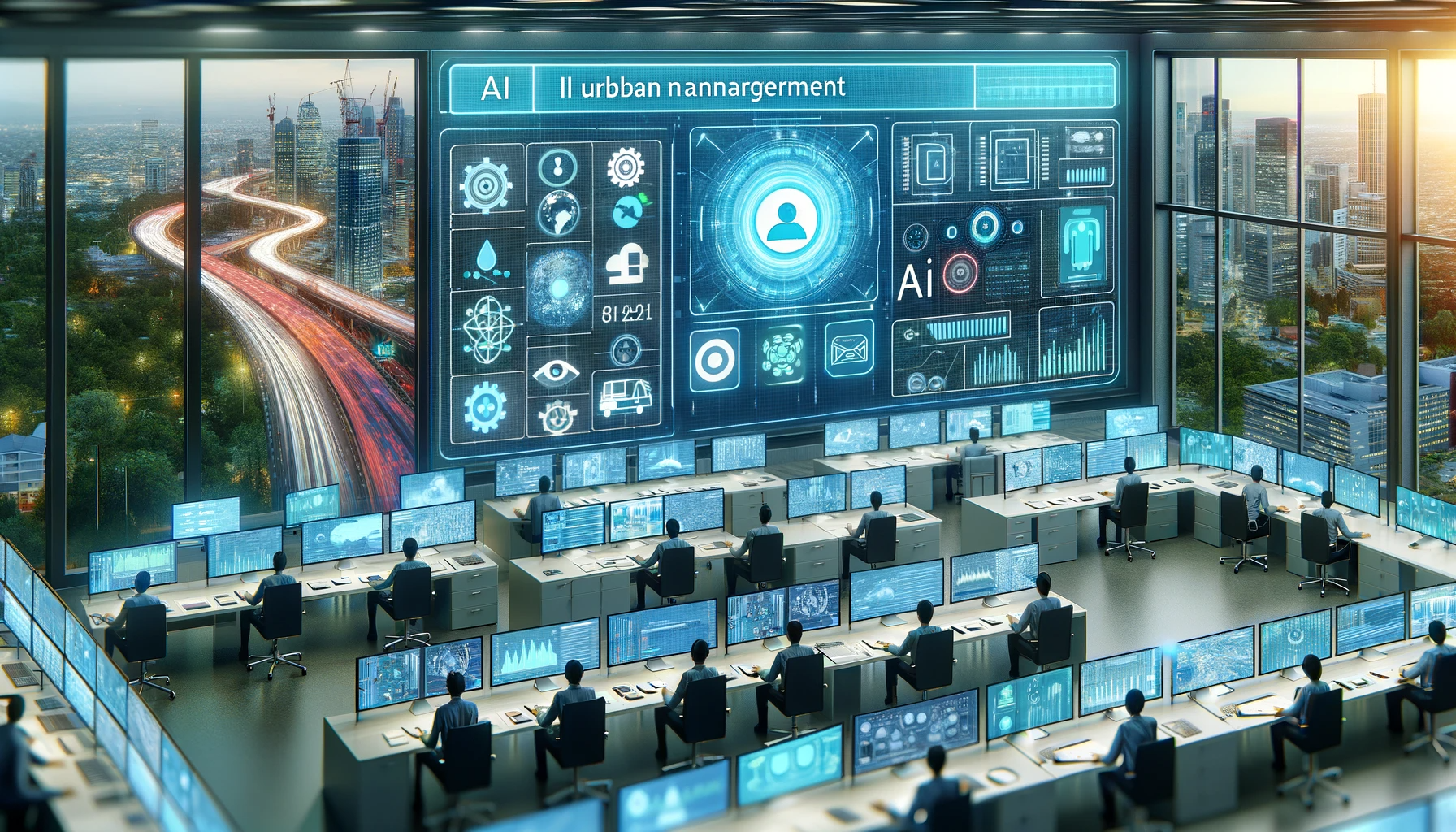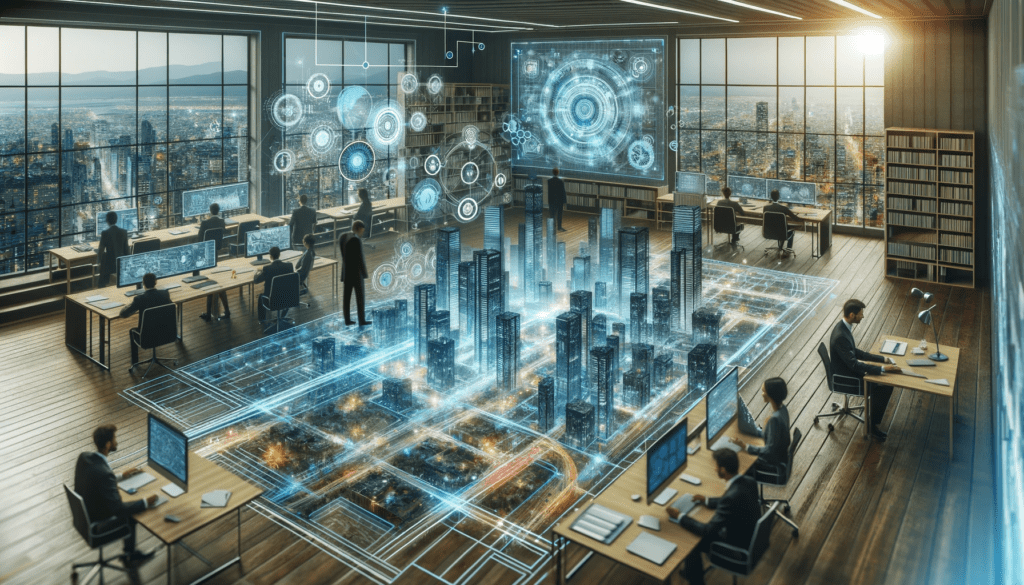As the world’s population continues its inexorable shift towards urban centers, the management and planning of cities have become increasingly complex and vital. Urbanization, while promising economic growth and opportunities, also brings forth a multitude of challenges, from traffic congestion and pollution to resource management and public service delivery. In this era of urbanization, a remarkable ally has emerged – Artificial Intelligence (AI).
AI, with its ability to process vast amounts of data, make predictive analyses, and optimize decision-making, has begun to reshape the landscape of urban planning and city management. This article embarks on a journey to explore the profound influence of AI in these domains, offering a glimpse into how technology is altering the way cities operate, develop, and serve their inhabitants.
As we delve into the realms of traffic management, sustainable city planning, and enhanced public services, we will unveil the ways in which AI technologies are becoming indispensable tools for city leaders and urban planners. From optimizing traffic flow to creating environmentally sustainable urban environments and improving the delivery of essential public services, AI is poised to change the way cities function.
The future of urbanization is, to a large extent, intertwined with the potential of AI to address the unique challenges of urban living. Join us on this exploration of how AI is set to change the landscape of urban planning and city management, offering innovative solutions to make our cities smarter, more efficient, and better equipped to meet the needs of their residents.
Defining the Urban Traffic Challenge

Urban traffic congestion has long been a thorn in the side of city dwellers, causing frustration, wasted time, and environmental harm. City streets, once designed to accommodate a smaller population of vehicles, have struggled to keep pace with the rapid growth of urban populations and the increasing number of vehicles on the road. The result is a daily struggle for commuters and a significant strain on city infrastructure.
The urban traffic challenge extends beyond mere inconvenience; it has far-reaching implications for productivity, air quality, and overall quality of life. As cities continue to expand, urban planners face the daunting task of finding innovative solutions to alleviate traffic congestion while ensuring sustainable transportation systems.
AI-Powered Traffic Management
The rise of Artificial Intelligence (AI) is reshaping the way cities approach traffic management. AI’s ability to analyze vast datasets in real-time, predict traffic patterns, and identify congestion points offers unprecedented insights into urban traffic dynamics. This newfound knowledge serves as the foundation for dynamic traffic management solutions that can adapt to changing conditions on the fly.
AI-powered traffic management encompasses a range of applications, from intelligent traffic signal systems to predictive analytics. These technologies work in tandem to optimize traffic flow, reduce congestion, and enhance the overall efficiency of urban transportation networks.
Case Studies in AI-Driven Traffic Management
To understand the transformative impact of AI in traffic management, it’s essential to explore real-world applications. Several cities around the world have embraced AI-driven traffic solutions with remarkable results.
One such city is Singapore, known for its advanced traffic management system, which relies heavily on AI. The city-state employs an intricate network of sensors, cameras, and data analytics to monitor traffic in real-time. AI algorithms process this data to predict traffic patterns, identify congestion-prone areas, and adjust traffic lights accordingly. As a result, Singapore has significantly reduced traffic congestion, improved travel times, and reduced carbon emissions, making it a model for AI-driven urban traffic management.
In Los Angeles, a city notorious for its traffic woes, AI has also made significant inroads. The Los Angeles Department of Transportation (LADOT) utilizes AI-powered traffic control systems to optimize traffic signals based on real-time conditions. These systems help alleviate congestion and improve traffic flow during peak hours, benefiting both commuters and the environment.
These case studies underscore the transformative potential of AI in traffic management, showcasing how technology can make urban mobility more efficient and sustainable. As cities continue to grapple with traffic challenges, AI offers a glimmer of hope for creating smarter and more responsive transportation systems.
The Promise of Autonomous Vehicles
The integration of AI with autonomous vehicles marks a significant paradigm shift in urban mobility. Autonomous vehicles, commonly known as self-driving cars, represent a culmination of AI’s transformative potential in the realm of transportation. These vehicles are equipped with a range of sensors, cameras, and AI algorithms that allow them to navigate without human intervention.
One of the promises of autonomous vehicles is their ability to communicate seamlessly with traffic management systems and other vehicles on the road. Through Vehicle-to-Everything (V2X) communication, self-driving cars can exchange information about their speed, direction, and intended maneuvers. This communication enables vehicles to coordinate their movements, reducing the likelihood of accidents and improving overall traffic flow.
Additionally, autonomous vehicles are designed to adhere strictly to traffic rules and regulations, minimizing human error, which is a leading cause of accidents. They can maintain consistent speeds, avoid aggressive driving behaviors, and respond quickly to changing traffic conditions. As a result, the integration of autonomous vehicles into urban transportation systems has the potential to reduce accidents, injuries, and fatalities on the road.
Beyond safety, autonomous vehicles have the capacity to significantly enhance urban mobility. Ride-sharing and autonomous taxi services, operated by AI, offer convenient and cost-effective alternatives to traditional car ownership. This shift towards Mobility-as-a-Service (MaaS) can reduce the number of privately owned vehicles on the road, alleviating traffic congestion and decreasing the demand for parking spaces in urban areas.
Challenges and Ethical Considerations
While AI holds the promise of revolutionizing traffic management, various challenges and ethical considerations must be addressed to ensure the successful and responsible deployment of AI-powered solutions.
One of the primary challenges is data privacy. The collection and analysis of vast amounts of data, including real-time traffic information and individual vehicle data, raise concerns about the potential invasion of privacy. Cities and organizations must establish robust data protection mechanisms and adhere to stringent privacy regulations to safeguard citizens’ information.
Another challenge lies in the infrastructure required to support AI-driven traffic management. To fully capitalize on AI’s potential, cities need to invest in advanced sensors, communication networks, and intelligent traffic systems. This infrastructure requires significant financial resources and meticulous planning.
Ethical considerations surrounding AI’s role in traffic enforcement also demand careful attention. Decisions made by AI algorithms, such as those related to traffic violations and penalties, should be transparent, accountable, and free from biases. Addressing these ethical concerns is crucial to ensuring public trust in AI-driven traffic management systems.

In conclusion, while AI offers transformative solutions for traffic management and urban mobility, addressing these challenges and ethical considerations is essential. With careful planning, responsible implementation, and a commitment to privacy and transparency, AI can indeed change the urban landscape for the better, making cities more efficient, sustainable, and safe for all.
In conclusion, the landscape of urban planning and city management is undergoing a profound transformation, and at the heart of this revolution lies Artificial Intelligence (AI). AI is not merely a technological innovation; it is a catalyst for reimagining how cities operate, develop, and serve their inhabitants. As we have explored the applications of AI in traffic management, sustainable city planning, and improved public services, it becomes evident that AI is a powerful tool that can address the complex challenges faced by cities worldwide.
AI-driven traffic management is not only optimizing traffic flow but also enhancing safety and reducing environmental impact. Dynamic traffic management solutions, empowered by AI, are revolutionizing the way cities tackle congestion and inefficiency on their roads. As we look to the future, the integration of autonomous vehicles promises further advancements in urban mobility, offering safer, more efficient transportation options that can alleviate traffic congestion and decrease accidents.
Sustainable city planning, guided by AI, holds the promise of environmentally responsible urban development. Through data analysis and optimization, AI is helping cities make informed decisions about land use, energy consumption, and infrastructure development. As cities embrace sustainable practices, they can reduce their carbon footprint, improve air quality, and create more livable urban environments for their residents.
AI’s role in enhancing public services is equally significant. In healthcare, education, and public safety, AI is improving access, efficiency, and quality. Predictive analytics, personalized learning, and enhanced disaster response are just a few examples of how AI is enhancing the lives of urban inhabitants.
However, the path to a more AI-driven urban future is not without challenges. Ethical considerations, such as data privacy, algorithmic bias, and transparency, demand careful attention. Cities must navigate these complexities with a commitment to ethical AI implementation and citizen engagement.
As we gaze into the horizon of urban planning and city management, one thing becomes clear: AI is poised to change the way we design, govern, and live in cities. The future of urbanization is intertwined with AI’s potential to address global urban challenges, such as climate change, rapid urbanization, and social inequalities. It is a future where cities become smarter, more efficient, and better equipped to meet the needs of their diverse and growing populations.
In this endeavor, policymakers, city leaders, technology innovators, and citizens must collaborate to harness AI’s full potential responsibly. Together, we can shape a future where AI creates more sustainable, livable, and inclusive urban environments, improving the quality of life for millions around the world. As the urban landscape continues to evolve, AI stands as a beacon of hope, guiding us toward cities that are not only smarter but also more humane and harmonious.
